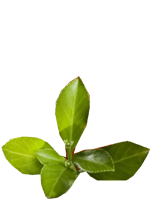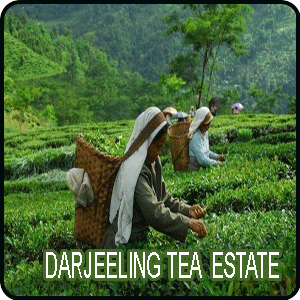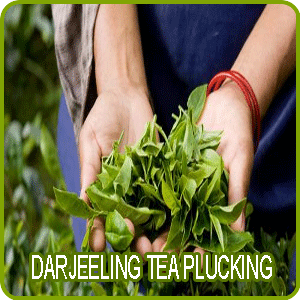 HISTORY OF DARJEELING TEA
HISTORY OF DARJEELING TEA
India takes the pride of owning the world famous Darjeeling tea which cannot be compared with its counterparts for it is unparalleled in the world. Darjeeling tea is from Darjeeling situated in the state of West Bengal. Tea is nearly 5000 years old and was first discovered in China, though aboriginal of both China and India. The botanical name for tea is Camellia Sinensis because it belongs to the family of Camellia and got the name Sinenesis for it was first discovered in China. The history of Darjeeling tea is nearly 150 years old when in 1841 a civil surgeon, Dr.Campbell planted some tea seeds in his garden experimentally in a place called Beechwood at Darjeeling at an altitude of about 7000ft above sea level. Dr. Campbell succeeded in raising the plant as a result of which the British Government helped him in putting up nurseries in that area.
 SLOWLY GOT COMMERCIALLY DEVELOPED
SLOWLY GOT COMMERCIALLY DEVELOPED
-Slowly this was getting commercially developed in the 1850's and by 1860's Darjeeling Tea Company was established with 4 gardens where there are mentions about Tukvar, Steinthal and Aloobari tea estates in records. All these estates used the seeds which were got from the government nurseries. Initially Darjeeling was a hill station just meant for the army and the affluent people. But soon the local people of Darjeeling and people from the neighboring country occupying the border of Nepal were also employed in the tea estates. Tea, being a labor intensive enterprise, required sufficient number of people to plant, tend, pluck and finally manufacture their produce. There are a number of varieties of Darjeeling tea which differ in its characteristics and flavor depending on the type of the soil, altitude and the climatic conditions of the particular area where the tea is grown.
 DARJEELING TEA AVAILABLE IN DIFFERENT COLORS
DARJEELING TEA AVAILABLE IN DIFFERENT COLORS
-They are available in different colors like black, green, white and oolong. When it undergoes a proper brewing it results in a thin-bodied, light-colored infusion with a floral aroma which can be featured with a tinge of astringent tannic characteristics, and a musky spiciness sometimes described as "muscatel". Mostly Darjeeling teas are commercially available as black tea they are more of oolong color than black because of the incomplete oxidation. Darjeeling tea is specially made from the small-leaved Chinese variety of Camellia sinensis when compared to the other Indian teas which are usually made from the large-leaved Assam plant (C. sinensis var. assamica).Though the traditional variety of tea which comes from Darjeeling is black tea, however now the oolong and the green teas are also becoming quite common. Lot of estates in Darjeeling are also now in the production of white tea.
 DARJEELING OWNS ABOUT 86 TEA ESTATES
DARJEELING OWNS ABOUT 86 TEA ESTATES-Darjeeling owns about 86 tea estates spread over an area of about 17,500 hectares which have been accorded the status for its produce, as Darjeeling Tea by the Tea Board of India. These estates produce about 10 million kg of tea annually and nearly half the total population of the district are employed in the tea estates. After the enactment of Geographical Indications of Goods (Registration & Protection Act, 1999) in 2003, Darjeeling tea became the first Indian product to receive a GI tag, in 2004-05 through the Indian Patent Office. India though known for different varieties of tea, the Darjeeling brewn teas takes a special place. The specialty of the Darjeeling tea is that they are grown in the ancient tea gardens which are bestowed with an excellent combination of sun, rain, humidity and rich soil.
 HARVEST TECHNIQUE OF DARJEELING TEA
HARVEST TECHNIQUE OF DARJEELING TEA
The growers are quite picky where they only pick the best of two leaves and one bud from every plant. While this picky harvest technique means that the tea produces low annual yields, it also explains why it's one of the most sought-after beverages in the world. The harvest process involves four major crops from the same tea bush every year. Thus each time the tea is picked four different character of tea is got in the harvest. The first crop which is got during the period of 1st week of March to the 1st week of May is known as 1st Flush. The characteristic features of the first flush crop are the tea is greenish and has a mild liquor and floral aroma. This is followed by the 2nd Flush of crop between the 3rd week of May to the 3rd week of June.
 CROP OBTAINED IN THE 2ND FLUSH IS MATURED
CROP OBTAINED IN THE 2ND FLUSH IS MATURED The crop obtained in this season is matured compared to the first season both in terms of flavor and liquor and in fact the world acclaimed muscatel flavor is pronounced during this particular season. The third set of crop which is generally referred as the rain crop is got between July to September is produced in bulk because of the heavy rain during this season and the flavor is also not very exclusive because of not enough sunshine resulting in a dark and dull character of the brew. The Autumnal Flush which is harvested from the last week of September to the 2nd week of November is generally the final crop of the year and it gives the strongest liquor as it passes through the summer and the monsoon and due to the sunshine of Autumn again after the long monsoon season and this tea is said to have a distinct aroma.
 FOUR COMMON VARIETIES OF DARJEELING TEA
FOUR COMMON VARIETIES OF DARJEELING TEAThere are four common varieties of the Darjeeling tea and they are Black Tea, Oolong Tea, Green Tea and White Tea. The black tea is the most preferred tea by the people of the Western countries. In the process of the production of the black tea the leaves feature a substantial change thereby letting the characteristic flavors of black tea � ranging from flowery to fruity, nutty and spicy � to dominate. The Oolong tea is the blend of both black and green tea which is fermented partially and hence also known as semi-fermented tea. At their best, oolongs are beautiful, full-bodied tea with a fragrant flavor and fruity, sweet aroma. Green tea is the tea of Asia which is also now becoming popular in the Western World. Its natural aroma and widely acclaimed health benefits make green tea appealing to both the tea lover and previously non-tea drinker.
 GREEN TEA AND WHITE TEA PREPARATION
GREEN TEA AND WHITE TEA PREPARATION
Green tea should be prepared with care for the water used for the preparation should be below boiling point for otherwise the infusion time will lead to bitterness. The White tea is supposed to be the finest variety of tea praised and featured for their eluciveness, complexity and natural sweetness. The preparation of White tea involves two steps and they are steamed and dried where the absence of withering, rolling and oxidation leaves the appearance of the leaves essentially unaltered.
 PLUCKING OF THE DARJEELING TEA LEAVES
PLUCKING OF THE DARJEELING TEA LEAVES
The plucking of the Darjeeling tea leaves is also distinct like its aroma. Plucking is done with great care for care in this generate a good flavor and quality. Usually the smallest shoot with two leaves and a bud are plucked and 22,000 such shoots are required to get 1kg of tea. The hilly terrain makes the work quite difficult in spite of which the tea puckers pick the tender leaves with their tender hands. The process of plucking is followed by withering in which the green leaves are evenly spread on a long narrow open container and then hot and cold air are blown in a regulated manner. The withering process is done mainly to remove the moisture content from the leaves and it is done over a period of nearly 14-16 hours. Now the withered leaves are put into rollers which by mechanical action twist the leaves. The process is carefully monitored so that the style of the leaf is maintained and overheating does not take place.
 ROLLING IS FOLLOWED BY FERMENTATION
ROLLING IS FOLLOWED BY FERMENTATION
Rolling is followed by fermentation during which the tea get its distinct flavor and aroma. Based on the temperature, humidity and leaf quality, fermentation takes place for about 2- 4 hours in which the leaf is spread in thin layers in a cool and steamy room. The role of the tea makers is very important because they have to decide the quality of the liquor based on their sensory judgments, they must also have an in-depth knowledge about the prevailing market conditions, consumer preferences and manufacturing techniques while evaluating the tea. These are endowments of birth - it would be true to say that Tea tasters are born and not made. In the process of drying the fermented leaves are put in the dryer where it is subjected to regulated varying temperature for a period of 20 - 30 min. Once the drying process is over, the resulting product is the black tea. Once the tea granules are ready it is then sorted according to the size and packed in specially designed foil lined packages.
 DARJEELING PLANTERS ASSOCIATION
DARJEELING PLANTERS ASSOCIATION
-There is a Darjeeling Planters Association where Annual general planters meeting take place. The first Annual General meeting of Darjeeling Planters took place in 1873 and came into existence in the year 1892. The main aim of this association is to discuss the problems associated with the industry and also to help the laborers employed in the estates in Darjeeling. In 1910 the Darjeeling Planters Association got the affiliation of the Indian Tea Association and now it is one of the constituent members of the "Consultative Committee of Plantation Associations" (CCPA) in India." This is one of the main incomes of the district and thus forming a major part of economy of the state. The workers of the tea estates enjoy a steady livelihood and other facilities like housing, statutory benefits, allowances, incentives, cr�ches for infants of working mothers, children's education, integrated residential medical facilities for employees and their families and many more. But in spite of all the facilities provided the industry is facing a lot of challenges.
 WORKERS ARE EMPLOYED TEMPORARILY EVERY YEAR DURING THE SEASON
WORKERS ARE EMPLOYED TEMPORARILY EVERY YEAR DURING THE SEASON-At present there are about 55,000 permanent workers in the estates and nearly 35,000 workers are employed temporarily every year during the season. The main reason behind labor shortage is that now people living there are aspiring for an urban life so that they are not branded as tea estate laborers. The Darjeeling tea industry is now planning to tie-up with Indian Institute of Plantation Management (IIPM) to find out ways to increase the productivity of the existing workforce.
 HISTORY OF DARJEELING TEA
HISTORY OF DARJEELING TEA  SLOWLY GOT COMMERCIALLY DEVELOPED
SLOWLY GOT COMMERCIALLY DEVELOPED DARJEELING TEA AVAILABLE IN DIFFERENT COLORS
DARJEELING TEA AVAILABLE IN DIFFERENT COLORS DARJEELING OWNS ABOUT 86 TEA ESTATES
DARJEELING OWNS ABOUT 86 TEA ESTATES
 HARVEST TECHNIQUE OF DARJEELING TEA
HARVEST TECHNIQUE OF DARJEELING TEA CROP OBTAINED IN THE 2ND FLUSH IS MATURED
CROP OBTAINED IN THE 2ND FLUSH IS MATURED  FOUR COMMON VARIETIES OF DARJEELING TEA
FOUR COMMON VARIETIES OF DARJEELING TEA GREEN TEA AND WHITE TEA PREPARATION
GREEN TEA AND WHITE TEA PREPARATION PLUCKING OF THE DARJEELING TEA LEAVES
PLUCKING OF THE DARJEELING TEA LEAVES
 ROLLING IS FOLLOWED BY FERMENTATION
ROLLING IS FOLLOWED BY FERMENTATION DARJEELING PLANTERS ASSOCIATION
DARJEELING PLANTERS ASSOCIATION WORKERS ARE EMPLOYED TEMPORARILY EVERY YEAR DURING THE SEASON
WORKERS ARE EMPLOYED TEMPORARILY EVERY YEAR DURING THE SEASON

